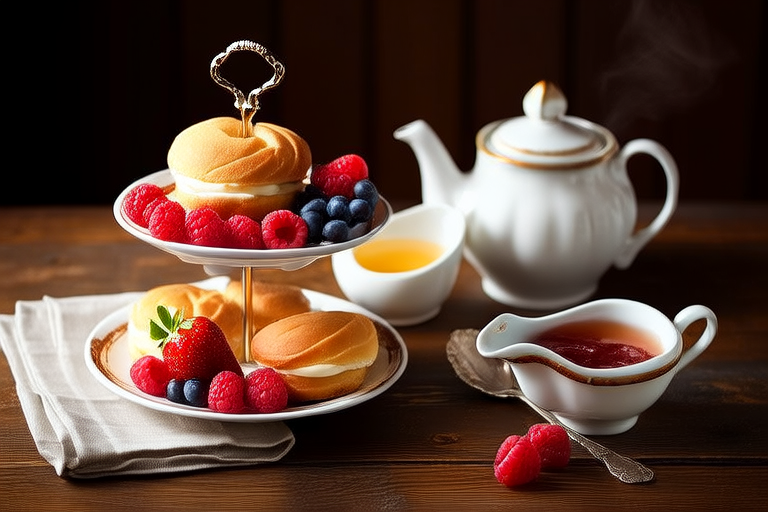Indulgent Afternoon Tea Experience: Cream Tea with Pastries
Welcome to the world of afternoon tea, an exquisite tradition that has been cherished for centuries. This indulgent experience is not just about sipping tea and nibbling on pastries; it’s a celebration of flavors, textures, and aromas that transport you to a realm of culinary delight. In this guide, we will explore the art of preparing the perfect cream tea with pastries, offering insights into the ingredients, techniques, and presentation that make this afternoon ritual truly special.
The History and Significance of Afternoon Tea
The concept of afternoon tea originated in England during the early 19th century. It was popularized by Anna, the 7th Duchess of Bedford, who found herself experiencing a “sinking feeling” in the late afternoon. To combat this, she began inviting friends to join her for a light meal consisting of tea, sandwiches, and cakes. Over time, this casual gathering evolved into a sophisticated social event, particularly among the upper classes.
Afternoon tea has since become a global phenomenon, embraced by tea enthusiasts and food lovers alike. It represents more than just a meal; it’s a moment of relaxation, a pause from the hustle and bustle of daily life. The ritual of afternoon tea encourages mindfulness and appreciation for the simple pleasures in life.
Selecting the Perfect Teas
The foundation of any successful afternoon tea is the selection of high-quality teas. For a cream tea experience, black teas such as Earl Grey, English Breakfast, or Darjeeling are typically chosen. These robust teas pair beautifully with the rich, buttery textures of pastries and the creamy indulgence of clotted cream.
Earl Grey, with its distinctive bergamot flavor, adds a refreshing twist to the classic cream tea. English Breakfast, a strong and malty tea, provides a bold contrast to the sweetness of the pastries. Darjeeling, often referred to as the “champagne of teas,” offers a delicate floral aroma that complements the subtlety of cream and scones.
For those who prefer a lighter touch, consider adding a herbal or fruit infusion like chamomile or rooibos. These alternatives provide a soothing counterpart to the richness of the cream tea experience.
The Art of Cream Tea
The heart of any cream tea lies in the preparation of the tea itself. Begin by selecting a high-quality loose-leaf tea. The use of loose-leaf tea allows for greater control over the brewing process, ensuring that each cup is perfectly balanced in terms of strength and flavor.
To prepare the tea, bring fresh, filtered water to a boil. Allow the water to cool slightly before pouring it over the tea leaves. A temperature of around 90°C (194°F) is ideal for most black teas, as boiling water can cause bitterness. Steep the tea for approximately three to five minutes, depending on your desired strength. Strain the tea into a warmed teapot or directly into cups.
Serve the tea with a small jug of milk and a sugar bowl. Cream teas traditionally call for clotted cream, a rich and thick dairy product produced by gently heating unpasteurized cow’s milk. The slow churning process creates a dense, buttery consistency that is unparalleled in texture and flavor. Clotted cream should be served at room temperature, allowing it to spread smoothly over the scones without melting.
Pair the tea with a selection of scones. Classic scones are made with flour, baking powder, salt, sugar, and heavy cream. They are traditionally baked until golden brown and slightly crispy on the outside, with a soft and tender crumb inside. Scones can be flavored with dried fruits, herbs, or spices to add an extra layer of complexity.
Pastries to Complement Your Cream Tea
No cream tea experience is complete without an array of delectable pastries. Choose a variety of sweet treats that offer contrasting flavors and textures. Start with a selection of classic sponge cakes, light and airy in texture, often filled with jam or cream. Madeira cake, a moist and flavorful sponge, is another excellent choice. Its subtle sweetness pairs wonderfully with the richness of the tea.
Incorporate some chocolate pastries into the mix. Rich chocolate éclairs, with their crisp pastry shells and velvety chocolate filling, are a delightful addition. Chocolate tarts, with their gooey, molten centers, provide a decadent contrast to the lighter sponge cakes. For those with a preference for less intense flavors, consider including a few lemon drizzle cakes. Their tangy citrus notes offer a refreshing balance to the sweetness of other pastries.
Don’t forget to include a selection of macarons. These delicate French confections come in a wide range of flavors and colors, from classic vanilla to exotic matcha and lavender. Their crisp, sandy shells encase a smooth and creamy filling, creating a harmonious blend of textures. Macarons are the perfect accompaniment to afternoon tea, offering a burst of flavor with every bite.
Presenting the Perfect Afternoon Tea
The presentation of your cream tea is just as important as the quality of the ingredients. Arrange the scones, pastries, and tea service on a tiered stand, starting with the heavier items on the bottom tier and moving to lighter, more delicate pastries on the top. Use elegant, mismatched china for added charm. Serve the tea in delicate bone china cups, which enhance the flavors and aromas of the tea.
Consider adding a few fresh flowers or greenery to the table for a touch of natural beauty. This not only enhances the aesthetic appeal but also creates a serene atmosphere conducive to relaxation and enjoyment.
Conclusion
An indulgent afternoon tea experience is more than just a meal; it’s a celebration of tradition, craftsmanship, and sensory pleasure. By carefully selecting high-quality teas, scones, and pastries, and presenting them with thoughtfulness and attention to detail, you can create a memorable and delightful afternoon tea experience. Whether enjoyed solo or shared with friends, the ritual of afternoon tea invites you to pause, savor, and appreciate the finer things in life.


